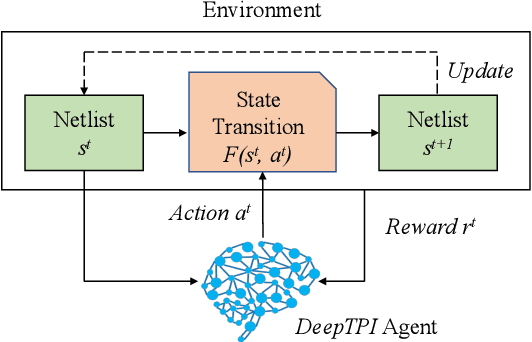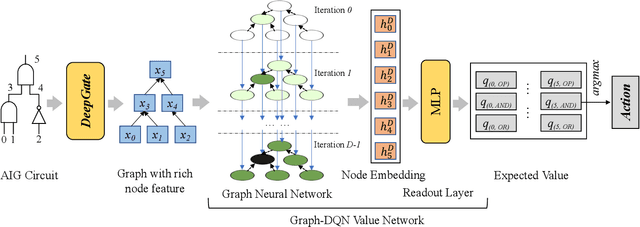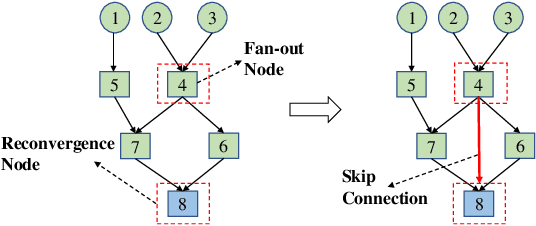Naixing Wang
Conflict-driven Structural Learning Towards Higher Coverage Rate in ATPG
Mar 04, 2023



Abstract:Due to the increasing challenges posed by the relentless rise in the design complexity of integrated circuits, Boolean Satisfiability (SAT) has emerged as a robust alternative to structural APTG techniques. However, the high cost of transforming a circuit testing problem to a Conjunctive Normal Form (CNF) limits the application of SAT in industrial ATPG scenarios, resulting in a loss of test coverage. In Order to address this problem, this paper proposes a conflict-driven structural learning (CDSL) ATPG algorithm firstly, in which the conflict-driven heuristic methods in modern SAT solver are implemented on the logic cone of fault propagation and activation directly. The proposed CDSL algorithm is composed of three parts: (1) According to the implication graph, various conflict constraints have been learned to prune search space. (2) Conflict-driven implication and justification have been applied to increase decision accuracy and solving efficiency. (3) A conflict-based diagnosis method is further proposed in the case of low coverage debug, leading to making the aborted faults testable by relaxing or modifying some constraints on primary inputs. Extensive experimental results on industrial circuits demonstrate the effectiveness and efficiency of the proposed CDSL algorithm. It is shown that compared with the SAT-based ATPG, the proposed CDSL can on average decrease $25.6\%$ aborted faults with $94.51\%$ less run time. With a two-stage computational flow, it has shown that the proposed CDSL can lead to $46.37\%$ less aborted faults than a one-stage structural algorithm, further with the $3.19\%$ improvement on fault coverage. In addition, the conflict diagnosis can lead to $8.89\%$ less aborted faults on average, and $0.271\%$ improvement in fault coverage rate.
DeepTPI: Test Point Insertion with Deep Reinforcement Learning
Jun 07, 2022



Abstract:Test point insertion (TPI) is a widely used technique for testability enhancement, especially for logic built-in self-test (LBIST) due to its relatively low fault coverage. In this paper, we propose a novel TPI approach based on deep reinforcement learning (DRL), named DeepTPI. Unlike previous learning-based solutions that formulate the TPI task as a supervised-learning problem, we train a novel DRL agent, instantiated as the combination of a graph neural network (GNN) and a Deep Q-Learning network (DQN), to maximize the test coverage improvement. Specifically, we model circuits as directed graphs and design a graph-based value network to estimate the action values for inserting different test points. The policy of the DRL agent is defined as selecting the action with the maximum value. Moreover, we apply the general node embeddings from a pre-trained model to enhance node features, and propose a dedicated testability-aware attention mechanism for the value network. Experimental results on circuits with various scales show that DeepTPI significantly improves test coverage compared to the commercial DFT tool. The code of this work is available at https://github.com/cure-lab/DeepTPI.
Representation Learning of Logic Circuits
Nov 26, 2021



Abstract:Applying deep learning (DL) techniques in the electronic design automation (EDA) field has become a trending topic in recent years. Most existing solutions apply well-developed DL models to solve specific EDA problems. While demonstrating promising results, they require careful model tuning for every problem. The fundamental question on \textit{"How to obtain a general and effective neural representation of circuits?"} has not been answered yet. In this work, we take the first step towards solving this problem. We propose \textit{DeepGate}, a novel representation learning solution that effectively embeds both logic function and structural information of a circuit as vectors on each gate. Specifically, we propose transforming circuits into unified and-inverter graph format for learning and using signal probabilities as the supervision task in DeepGate. We then introduce a novel graph neural network that uses strong inductive biases in practical circuits as learning priors for signal probability prediction. Our experimental results show the efficacy and generalization capability of DeepGate.
 Add to Chrome
Add to Chrome Add to Firefox
Add to Firefox Add to Edge
Add to Edge